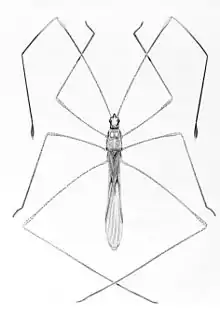Berytidae
Berytidae is a family of the order Hemiptera ("true bugs"), commonly called stilt bugs[3] or thread bugs.[4]
| Stilt bugs | |
|---|---|
 | |
| Dorsal view of a typically gracile species in the family Berytidae | |
| Scientific classification | |
| Kingdom: | Animalia |
| Phylum: | Arthropoda |
| Class: | Insecta |
| Order: | Hemiptera |
| Suborder: | Heteroptera |
| Infraorder: | Pentatomomorpha |
| Superfamily: | Lygaeoidea |
| Family: | Berytidae |
| Subfamilies [1] | |
|
Berytinae Fieber, 1851 Gampsocorinae Southwood and Leston, 1959 Metacanthinae Douglas and Scott, 1865 | |
| Synonyms[2] | |
| |
Description
The Berytidae are extremely gracile insects with legs so long and slender as to suggest common names such as "thread bugs" and "stilt bugs". In this they resemble the Emesinae, with which they are easily confused, though they are in different families. They may be distinguished most readily by the forelegs, that in the Emesinae are raptorial in a way resembling those of the Mantodea, Mantispidae and certain other invertebrate predators. In form and function the forelegs of the Berytidae are roughly similar to those of their other legs. Other differences are subtler and not fully consistent. For one thing, the antennae of most Berytidae though long, geniculate, and in other ways generally similar to Emesinae, tend to have a more or less obvious swelling at the tip. Some members of the family also have slight swellings at the distal ends of the femora of their legs, though in many species this is either absent or not obvious.
Biology
The habits of most species are not well known. Most are believed to be sap-suckers like most other Hemiptera, but some also feed on mites and small insects.
Taxonomy
These 37 genera belong to the family Berytidae. One common genus in this family is Neides[1][5][6]
- Apoplymus Fieber, 1859
- Australacanthus Henry, 1997
- Berytinus Kirkaldy, 1900
- Berytoplymus Stusak, 1989
- Bezu Stusak, 1989
- Cametanthus Stusak, 1967
- Capyella Breddin, 1907
- Chinoneides Stusak, 1989
- Cuscohoplininus Dellapé & Carpintero, 2007
- Diabolonotus Henry, 1996
- Dimorphoberytus Stusak, 1965
- Gampsoacantha Josifov & Stusak, 1987
- Gampsocoris Fuss, 1852
- Hoplinus Stal, 1874
- Hubertiella Kirkaldy, 1902
- Jalysus Stal, 1862
- Metacanthus Costa, 1847
- Metajalysus Stusak, 1977
- Metatropis Fieber, 1859
- Micrometacanthus Lindberg, 1958
- Neides Latreille, 1802
- Neoneides Stusak, 1989
- Neostusakia Kment, Henry & Frýda, 2009
- Oedalocanthus Henry, 1996
- Paleologus Distant, 1902
- Paraberytus Stusak, 1965
- Parajalysus Distant, 1883
- Phaconotus Harris, 1943
- Plyapomus Stusak, 1976
- Pneustocerus Horvath, 1905
- Pronotacantha Uhler, 1893
- Tirybenus Stusak, 1964
- Triconulus Horvath, 1905
- Xenoloma Harris, 1943
- Yemma Horvath, 1905
- Yemmalysus Stusak, 1972
- Yemmatropis Hsiao, 1977
References
- Dellapé, Pablo M.; Henry, Thomas J. (2019). "family Berytidae Fieber, 1851". Lygaeoidea Species File. Retrieved 2019-06-19.
- "Neididae Report". Integrated Taxonomic Information System. Retrieved 2018-04-23.
- Thomas J. Henry (1997). Monograph of the stilt bugs, or Berytidae (Heteroptera) of the Western Hemisphere. Entomological Society of Washington.
- Alan Weaving; Mike Picker; Griffiths, Charles Llewellyn (2003). Field Guide to Insects of South Africa. New Holland Publishers, Ltd. ISBN 1-86872-713-0.
- "Berytidae". GBIF. Retrieved 2019-06-19.
- "Family Berytidae information". BugGuide.net. Retrieved 2019-06-19.
Gallery
 Stilt bug, possibly juvenile?
Stilt bug, possibly juvenile? Unknown species
Unknown species Stilt bug
Stilt bug Stilt bug, Berytidae
Stilt bug, Berytidae